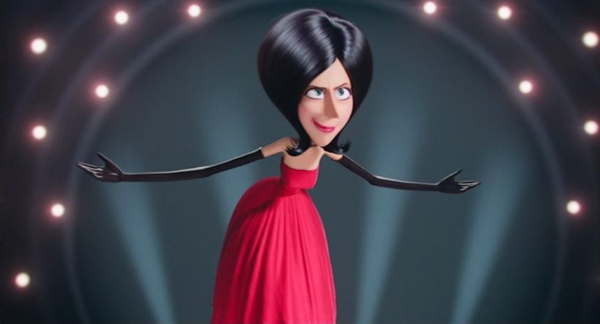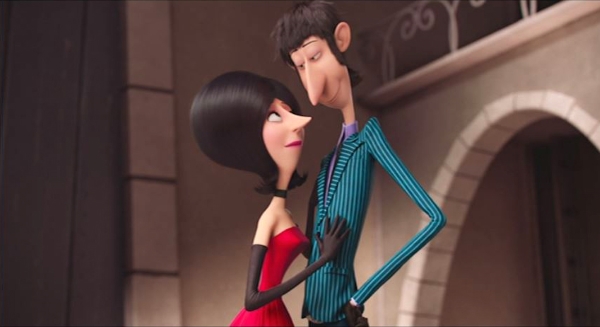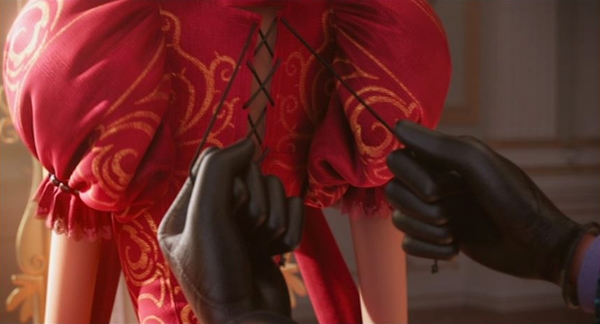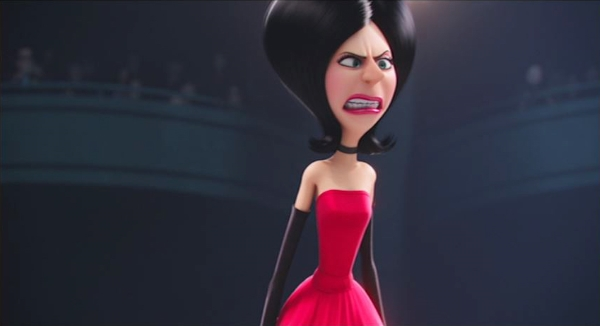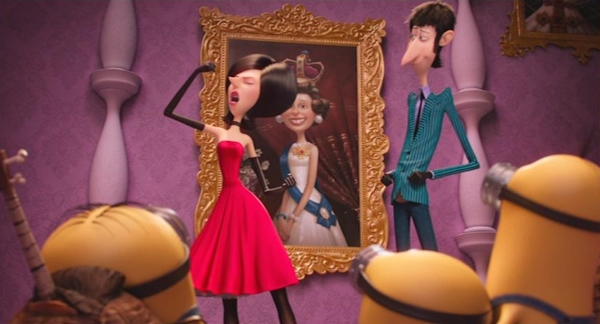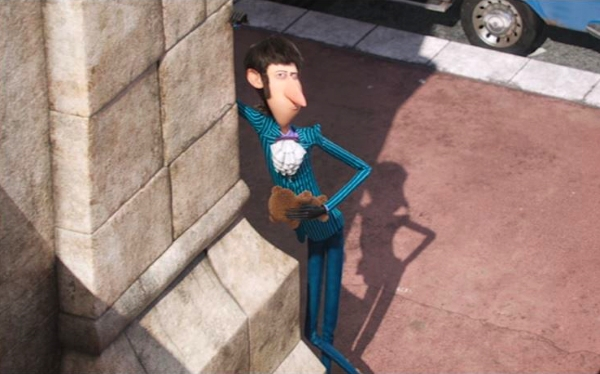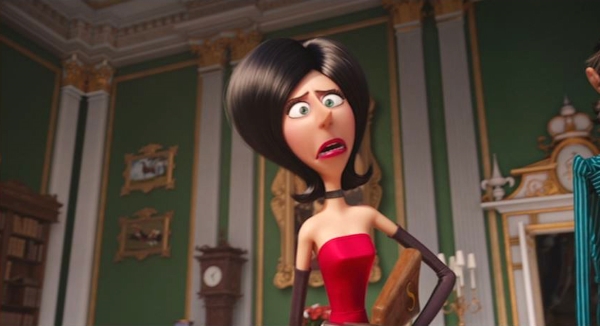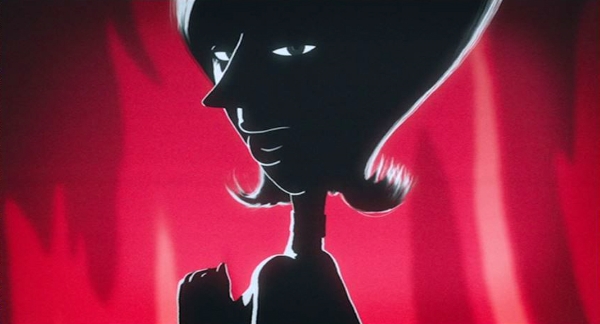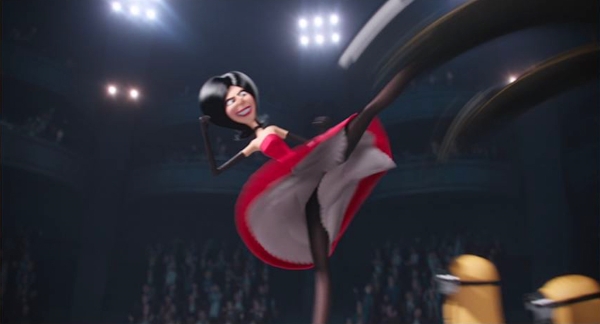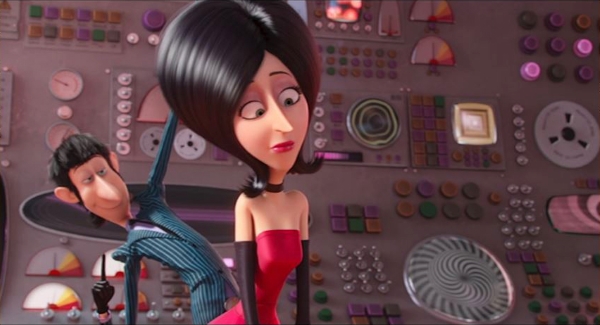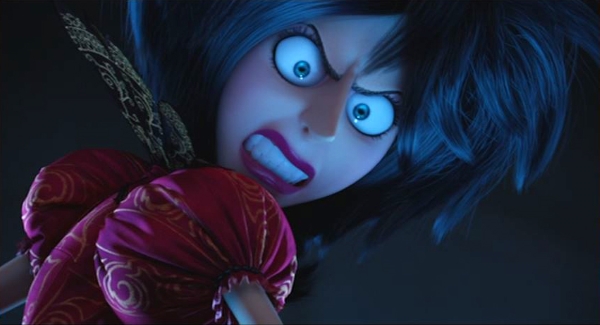Once upon a time, a female supervillain by the name of Scarlet Overkill was born in Minions, a spin-off from Illumination Entertainment’s Despicable Me. (If you’re new to this franchise, the least you need to know is that it began with the redemption story of supervillain Felonius Gru.)
Scarlet Overkill, voiced by Academy-Award winner Sandra Bullock, is a supervillain of epic proportions. She’s a master thief, an accomplished pilot, and an expert fighter. Her huge, fairy tale castle fortress towers over London and includes a treasure-filled loot room. An ambitious woman, she’s skilled at marketing her brand and building a criminal empire. If there’s one word that best describes Scarlet Overkill, it’s “powerful.”
Scarlet is a unique supervillain because she’s married to Herb, her inventor and sidekick. His hipster, laid-back style perfectly complements her kinetic personality. They’re equal partners and also equally cool. The best part is that the Overkills are wildly in love with each other; their hot romance is off the charts!
While Scarlet Overkill has an amazing skill set and looks absolutely fabulous in her rocket dress, her characterization is flawed and messy. Not only that, she’s a painful reminder about the general lack of mainstream female villains with redemption stories. This is a longtime pattern, and we need to talk about how to change it.
Because Scarlet Overkill isn’t bad. She’s just written that way.
I’d like to explore what’s possibly at the root of this issue. But first, let’s examine a few of Scarlet Overkill’s problematic elements.
Hypersexual Characterization
Scarlet Overkill is hypersexualized in a number of ways, including:
- Everything about her character screams “sexpot”: red, strapless dress; choker; stilettos; black gloves and pantyhose, prominent derriere; gravity-defying breasts, and full red lips.
- Various shots depict Scarlet in ways meant to appeal to the heterosexual male gaze, such as when she adjusts her bodice while flying through the air during her Villain-Con performance. The implication is her breasts could pop out at any moment, a fantasy meant to titillate.
- BDSM subtext (e.g., Herb tightening her coronation dress implies bondage play. It’s pretty hot, actually, except for the implication that their bondage predilection is part of what makes them evil.)
- Scarlet uses sex to market herself (e.g., television commercial; magazine picture of her that Kevin the Minion ogles much like a Playboy magazine).
Lack of Agency
Because the narrative is centered on the Minions, Scarlet’s character is framed as incompetent even though such a depiction defies logic in light of what we’re shown (and mostly told) about her abilities. For example, at Villain-Con, Scarlet challenges attendees to take her ruby in order to win the job of being her henchpeople. Yet despite her stellar fighting abilities, she can’t keep a tiny Minion from seizing her ruby. This sends a toxic message not only about her skills, but also that Scarlet is a prize to be won by male characters.
Think I’m reading too much into this? Then flip the script. If Scarlet had been man, would the test for becoming his henchpeople have been the same: to claim his ruby? Since when are supervillains less powerful than their sidekicks?
Instead of asking, “Who has the ruby?” Scarlet should have asked, “Who has my agency?”
During the scene when Scarlet explains the Minions’ first mission, she says, “Steal me the crown, and all your dreams come true. Respect. Power!”
The examples she presents are meant to be a humorous subconscious slip, but her goals are worthy nevertheless. It’s a striking reveal: Scarlet doesn’t care about wealth or possessions; rather, her dream is to be validated. She craves the same kind of privilege accorded to the men of her world. She wants to be considered their equal.
Unfortunately, Minions spends the rest of the time tearing down this powerful woman, punishing her for being sexually active and wanting respect and power. As with similar characters, Minions reinforces the message that a talented woman like Scarlet Overkill can’t—and shouldn’t—win at the game of life.
Therefore, no matter how much the filmmakers regard Scarlet as “a nod to 1960s feminism,” the story erases the very feminism it purportedly supports.
Scarlet Overkill as Plot Device
Ultimately, Scarlet’s character, whether male or female, is one in service to the ongoing narrative of Felonius Gru, the Despicable Me franchise’s flagship supervillain.
But Scarlet is female, and she appears in the context of the longtime pattern of female characters being in service to a male protagonist’s heroic journey (e.g., Manic Pixie Dream Girl and characters like The Lego Movie’s Wyldstyle). A deliberate choice was made to place a female villain in this position instead of as the lead in her own story. For all her accomplishments, Scarlet is little more than a plot device. So much for her being the “greatest supervillain of all time,” eh?
Now contrast Scarlet Overkill, a disposable character with an under-developed backstory, with that of Gru, who’s recycled over and over again. To be clear, I’m not saying Scarlet shouldn’t have faced consequences for her villainy. She did some naughty things, but it doesn’t change the fact that there’s a much longer list of male villain redemption stories than female ones. The Despicable Me franchise is simply the most recent and blatant example of that.
I have a theory about why Scarlet came packaged with so many sexist, problematic elements, and it has frightening implications for female villains everywhere.
Scarlet Overkill: Sexual Fantasy Woman
On the surface, Scarlet is Minions’ antagonist, but other elements about her, especially her hypersexual characterization, seem to serve another purpose—namely, as a sexual fantasy figure, one engineered by and geared towards heterosexual men.
The core Minions filmmaking team—co-directors Pierre Coffin and Kyle Balda; screenwriter Brian Lynch; and production and character designer Eric Guillon—are all male. Presumably, they’re the folks who created Scarlet Overkill. At the very least, they probably had the most input into her development.
This group would have been the first consumers of her character, so they probably decided to envision one they’d enjoy looking at, and—let’s be real here—one with whom they’d like to have sex.
From a marketing perspective, it’s possible Scarlet’s hypersexual characterization was a deliberate choice for the simple reason that sex sells. One thing we know for sure is that the team had adult viewers in mind when crafting the movie. In an interview with Flickering Myth, Pierre Coffin shared that the team included elements in Minions for parents:
Everybody’s sort of expecting this movie for kids, but the truth is we were having more fun doing our movie our way than having constantly in mind, “Oh, we can’t do that, it’s for 4- to 8-year-olds.” We’re always thinking about the poor parents who will be accompanying their children to the movies, because we live that thing every week. “What do they wanna see? Oh God, here we go again,” and usually I’ll be super bored or just mildly enjoy it. So you want to care about the parents, like the kids will get the jokes at their own level, but the parents will enjoy it for other things.
As a parent myself, I appreciate their efforts, and I did enjoy some of those “other things” in Minions, particularly the dynamic duo of Scarlet and Herb. But that doesn’t mean all of those “other things” are the best, most considerate choices, especially given the subtext that a female villain is someone to be used and ultimately discarded after viewers have had their way with her.
Regardless of why the filmmakers chose to hypersexualize Scarlet, the act alienates and marginalizes a whole subset of the film’s audience, namely women and girls. Intent =/= impact. Scarlet Overkill’s hypersexualization is harmful because it sends the message that it’s okay to sexually exploit female villains—and by extension, women in general.
Many female villains are and have been characterized as hypersexual. Scarlet Overkill is no different. The pattern has simply been expanded with yet another character. She’s sexy, therefore she must be evil. Scarlet’s marriage to Herb subverts her sexpot aspect somewhat, but not enough where it truly matters.
The screencap below breaks my heart, because all I see is a female character being used to titillate without her consent. If it’s not abundantly clear, the composition implies a simulation of sexual intercourse. These types of shots don’t happen by accident in animation, where pre-planning is a crucial part of the process.
I don’t believe the core filmmaking team meant to be sexist or cause harm. Rather, I suspect Scarlet Overkill’s characterization is a bad case of unexamined sexism. How else to explain the film’s copious use of the male gaze and her hypersexualized nature? How else to explain why the story sabotages her feminist elements? How else to explain why the franchise’s first female supervillain is only given about twenty minutes of screen time?
And here’s the real $64,000 question: Would an all-woman filmmaking team have deliberately chosen to make Scarlet Overkill such a hypersexualized character?
I would have been 100% willing to embrace a version of Scarlet that was sexy and pretty without being hypersexual. Because seriously, it’s not as if the Minions cash cow, with its deluge of merchandise, would have suffered as a result. In fact, there’s even a chance the movie would have been better. Alas, we’ll never know what a more nuanced portrayal would have looked like, because the filmmakers made a deliberate choice to reduce Scarlet to the sum of her body parts.
How Illumination Entertainment Wrote Scarlet Overkill Into a Corner
Scarlet’s depiction as a sexual fantasy figure negatively impacts the chances of her headlining her own film. Why? Because making her a hero would mean admitting a hypersexual female villain is worthy of redemption.
And in these times, that’s a tall order indeed.
Unfortunately, the problem doesn’t just lie with studios like Illumination Entertainment. Audiences may also resist the idea of a powerful villainess earning redemption because of entrenched sexism.
Redemption stories are a privilege usually reserved for male villains.
On second thought, perhaps Illumination was fully aware of its actions. A female supervillain helped diversify the franchise, but hypersexualizing her character seems like a sure way to guarantee that the sexy, vampy Scarlet Overkill would never be granted her own redemption movie. They’d undoubtedly consider the risk too great given the cultural script that demands we as a society must routinely deny female villains the chance to become heroes. For far too many people, it’s not enough that so many women are oppressed in real life—their fictional counterparts must be relegated to the sidelines as well.
Looking to the Future
Despite the issues with Scarlet Overkill’s character, the seeds of a great female supervillain redemption story are there. Such a film would be a great way to reboot the franchise and address its gender imbalance after Gru’s time in the spotlight is over.
A Scarlet Overkill film helmed by female filmmakers would also be a chance to reclaim Scarlet and mold her into a compelling character that would better reflect the needs and interests of female viewers. Coffin and company had their fun with their sex doll version of her. Now it’s time to bring a female villain like Scarlet Overkill into the 21st century.
What might such a redemption story look like? First, let’s examine Gru’s character. Gru is a stoic, emotionally inhibited man. His character arc in Despicable Me involves learning to get in touch with his emotions so he can be a good father to his three adopted daughters. It’s a story many can relate to—if you’re an emotionally inhibited man.
Scarlet, on the other hand, is an expressive person who strategically uses her emotional arsenal to influence others. She’s in control and knows exactly what she’s doing when she alternates between sweetness and anger. This is part of what makes her an effective supervillain.
In order for Scarlet to earn redemption, she’d need to learn to effectively manage her emotions and channel them into something positive. She’d still be entitled to dramatic emotional displays as long as they help others rather than harm.
Despite that story arc’s potential appeal, there’s a general resistance to female characters expressing intense negative emotions. In Minions, some of Scarlet’s emotional outbursts are pretty gonzo. In the context of a redemption story, would audiences perceive them to be as valid as Gru’s repressed emotions? That kind of emotional journey would represent new narrative territory.
Scarlet’s emotional expressiveness may trigger sexist attitudes about women and their anger. People react differently to angry women than they do to angry men in real life, so it’s conceivable similar attitudes extend to fictional female villains, as well. Such dynamics may play a role in the lower number of female villain redemption stories, especially if studio heads are buying into that kind of gender bias.
One other major issue: What’s to be done about the hypersexualization of female villains? Well, the solution is almost too simple: ease up on that trend. Women come in all shapes, sizes, colors, and sexual orientations, so female villains can and should reflect that. Two templates for non-hypersexual character designs are Rose Wilson (Teen Titans Go) and Ma-Ma (Dredd). There are more in Sara Goodwin’s post here about animated female villains. Let’s strive towards a time when hypersexualized female villains aren’t the default.
In conclusion, I’d love nothing more than to be proven wrong about all of this. I’d love for movie studios to release more female villain redemption stories. I’d love for audiences to flock to these films, fall in love with the characters, and assuage my fears.
Sadly, Scarlet Overkill is probably a lost cause as far as headlining her own redemption story. Despite being a hardcore fan, my cynicism far outstrips my hope, but if we remain aware of this issue and keep having this conversation, perhaps one day, her future sisters in villainy will be considered golden opportunities.
(images via Universal Pictures)
Heather Massey searches for sci-fi romance adventures and writes about them at Galaxy Express 2.0 and Sci-Fi Romance Quarterly. She tweets about SFR @thgalaxyexpress and squees about her favorite supervillain couple Scarlet and Herb @TheOverkills. When she’s not reading or writing about SFR, Heather geeks out with her husband and daughter over shows like Steven Universe.
—Please make note of The Mary Sue’s general comment policy.—
Do you follow The Mary Sue on Twitter, Facebook, Tumblr, Pinterest, & Google +?



